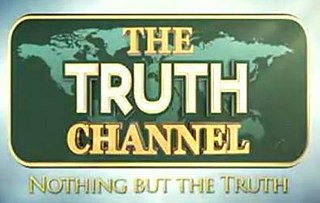
Digital Video Broadcasting (DVB) is a set of international open standards for digital television. DVB standards are maintained by the DVB Project, an international industry consortium, and are published by a Joint Technical Committee (JTC) of the European Telecommunications Standards Institute (ETSI), European Committee for Electrotechnical Standardization (CENELEC) and European Broadcasting Union (EBU).
Free-to-air (FTA) services are television (TV) and radio services broadcast in unencrypted form, allowing any person with the appropriate receiving equipment to receive the signal and view or listen to the content without requiring a subscription, other ongoing cost, or one-off fee. In the traditional sense, this is carried on terrestrial radio signals and received with an antenna.

The VRT is the national public service broadcaster for the Flemish Community of Belgium.
Television has a long history in Ukraine, where regular television broadcasting started during the Soviet years in 1951. However the first ever TV broadcast took place on 1 February 1939 in Kyiv. Since then TV broadcasting has expanded, particularly after the fall of Communism in 1989, and now there are many different channels and groups in the Ukrainian TV market.

Television in Israel refers to television broadcasting services in the State of Israel, inaugurated on March 24, 1966. Initially, there was one state-owned channel, operated jointly by the Israel Broadcasting Authority and the Israeli Educational Television. In 1986, a second state-regulated channel was launched. This channel became a state-regulated commercial channel in 1993. An additional commercial channel was introduced in 2002, followed by the introduction of three commercial niche channels: an Israeli Russian-speaking channel, a channel of Israeli popular music and an Arabic-speaking channel. Colour transmissions were introduced gradually around 1977 and 1979. Multichannel cable television service became available to subscribers gradually since 1989, although illegal cable TV stations were present in the big cities during the 1980s. Satellite-based multichannel service has been available since 2000.
Television in Germany began in Berlin on 22 March 1935, broadcasting for 90 minutes three times a week. It was home to the first regular television service in the world, named Fernsehsender Paul Nipkow.

Television in Vietnam began to appear in the mid-1960s in Saigon, with the appearance of Saigon Television Station. In 1970, in the North, Voice of Vietnam broadcast the first test television program. In the late 1970s, color television was introduced and broadcast experimentally. Today, television in Vietnam is available in many modes of broadcasting, with many national and local channels, broadcast or pay with more than 200 channels available to viewers. Vietnam completed the digital television transitions on December 28, 2020.

A digital television adapter (DTA), commonly known as a converter box or decoder box, is a television tuner that receives a digital television (DTV) transmission, and converts the digital signal into an analog signal that can be received and displayed on an analog television set. Some also have an HDMI output since some TVs with HDMI do not have a digital tuner. The input digital signal may be over-the-air terrestrial television signals received by a television antenna, or signals from a digital cable system. It normally does not refer to satellite TV, which has always required a set-top box either to operate the big satellite dish, or to be the integrated receiver/decoder (IRD) in the case of direct-broadcast satellites (DBS).
DVB-T2 is an abbreviation for "Digital Video Broadcasting – Second Generation Terrestrial"; it is the extension of the television standard DVB-T, issued by the consortium DVB, devised for the broadcast transmission of digital terrestrial television. DVB has been standardized by ETSI.
Television in Iceland is composed of the public broadcasting service of RÚV, five free-to-view channels and a number of subscription channels provided by private broadcasters. Broadcasts began in 1955 when the American Forces Radio and Television Service (AFRTS) started an English-language television service broadcasting from Naval Air Station Keflavik, which operated until 2006. The first Icelandic-language television broadcasts started in September 1966 with the launch of RÚV, originally called Sjónvarpið. In 1986, the first privately owned TV station, Stöð 2, began broadcasts. In recent years, the emergence of foreign internet streaming services, such as Netflix and Disney+, has seen a shift from domestic providers provide similar on demand streaming services such as Síminn Premium and Stöð 2+.
Norman Rentrop is a German billionaire, publisher, author and investor.
TV Vlaanderen is a digital satellite television and terrestrial television service provider for the Flanders region in Belgium.

Norkring AS is a provider of digital terrestrial television and radio transmitting in Norway and Belgium. In Norway, Norkring operates a Digital Video Broadcasting – Terrestrial (DVB-T) network for Norges Televisjon, as well as an FM and Digital Audio Broadcasting (DAB) radio. In Belgium, Norkring operates a DVB-T, DVB-T2, FM, DAB and DAB+ network. It operated a DVB-T network in Slovenia between 2010 and 2012. Norkring is owned by Telenor; Norkring België is owned 75 percent by Norkring and 25 percent by Participatiemaatschappij Vlaanderen.

Television in Colombia or Colombian television is a media of Colombia. It is characterized for broadcasting telenovelas, series, game shows and TV news. Until 1998 it was a state monopoly. There are two privately owned TV networks and three state-owned TV networks with national coverage, as well as six regional TV networks and dozens of local TV stations. There are numerous cable TV companies operating in Colombia under each Colombian department statutes. These cable companies also develop their own channels, in addition to a variety of international channels. Television in Colombia has always relied on technological advancements from developed countries importing almost all the equipment.
Television in Belgium was introduced in 1953 and began with one channel each in Dutch and French. The country is heavily cabled, with 93% of households watching television through cable as of 2003.
Television is the most popular medium in Russia, with 74% of the population watching national television channels routinely and 59% routinely watching regional channels. There are 6,700 television channels in total. Before going digital television, 3 channels have a nationwide outreach : Channel One, Russia-1 and NTV.

Servus TV is a TV station based in Wals-Siezenheim in the Austrian state of Salzburg and owned by Red Bull Media House GmbH, a subsidiary of Red Bull GmbH, which also publishes the magazine Servus in Stadt und Land. The station is the successor to Salzburg TV, founded in 1995 and rebranded in 2009. It is politically aligned with the far right.

Spas is a federal channel in Russia which is associated with the Russian Orthodox Church. It started broadcasting in on July 28, 2005. The main owner of the channel is the Moscow Patriarchate of the Russian Orthodox Church. The founders of the TV channel are Alexander Batanov and Ivan Demidov.

The Truth Channel, originally The Old Path (TOP) Channel, is a religious broadcast station of the Members Church of God International (MCGI), an international Christian organization with headquarters in the Philippines. Formerly called as TOP Channel, The Truth Channel carries the 24/7 English broadcast of Ang Dating Daan, the longest-running religious program in the Philippines, hosted by international televangelist and MCGI's Overall Servant Bro. Eli Soriano for English-speaking countries in North America, Middle East, Europe and Asia. The MCGI leadership decided to air The Old Path program using several satellites to increase its reach and expand the propagation efforts of the church on a global scale.










